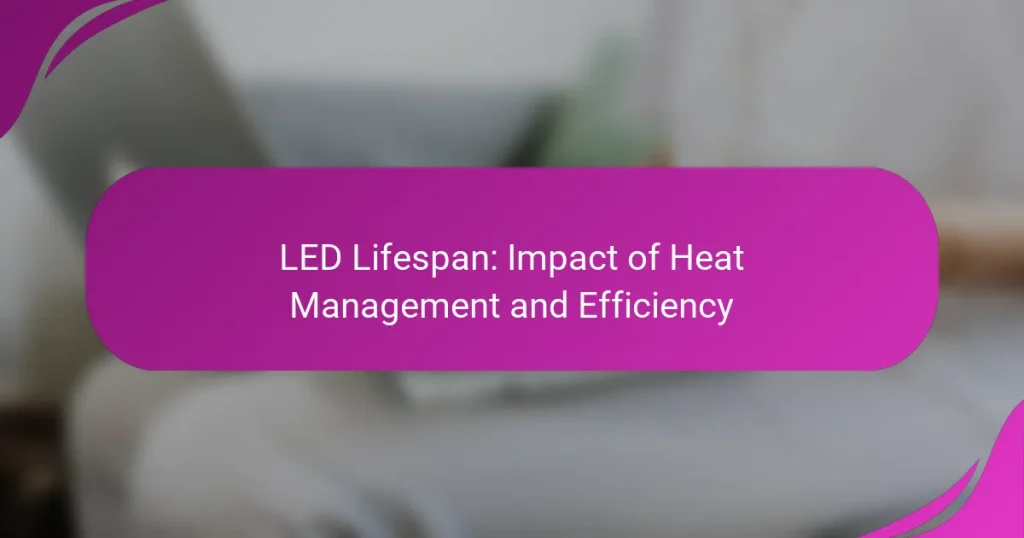Heat management plays a critical role in determining the lifespan of LEDs, as it directly affects the thermal conditions in which they operate. By ensuring effective heat dissipation, the operational life of LEDs can be significantly extended, while excessive heat can lead to premature failure and diminished efficiency. Additionally, the efficiency of an LED influences how much energy is converted into light versus wasted as heat, with higher efficiency models generating less heat and thereby enhancing longevity.

How does heat management affect LED lifespan?
Heat management significantly impacts LED lifespan by influencing the thermal conditions under which LEDs operate. Proper heat dissipation can extend the operational life of LEDs, while excessive heat can lead to premature failure and reduced efficiency.
Heat dissipation techniques
Effective heat dissipation techniques are crucial for maintaining LED performance. Common methods include using heat sinks, thermal pads, and active cooling systems. Heat sinks, typically made of aluminum, absorb and disperse heat away from the LED, while thermal pads enhance the thermal interface between the LED and the heat sink.
Another technique is the use of thermal conductive materials that facilitate heat transfer. Selecting the right materials and designs can significantly improve heat management, leading to longer LED lifespans.
Impact of temperature on LED performance
Temperature directly affects LED performance and longevity. Operating temperatures above the recommended range can reduce light output and color accuracy, while also increasing the likelihood of failure. Generally, maintaining temperatures below 85°C is advisable for optimal performance.
As temperatures rise, the efficiency of LEDs can drop, leading to increased energy consumption and reduced brightness. Understanding the thermal characteristics of specific LED models can help in selecting the right components for various applications.
Cooling solutions for LED fixtures
Implementing effective cooling solutions is essential for LED fixtures, especially in high-output applications. Passive cooling methods, such as heat sinks, are often sufficient for standard installations, while active cooling, like fans or liquid cooling systems, may be necessary for high-performance setups.
When designing LED fixtures, consider the environment and application. For instance, outdoor fixtures may require additional weatherproofing and enhanced cooling strategies to cope with fluctuating temperatures. Regular maintenance and monitoring can also help ensure that cooling systems remain effective over time.

What are the best practices for LED heat management?
Effective heat management is crucial for maximizing the lifespan and efficiency of LEDs. Implementing best practices can significantly reduce thermal stress, ensuring optimal performance and longevity.
Using heat sinks effectively
Heat sinks are essential for dissipating heat away from LED components. They should be made from materials with high thermal conductivity, such as aluminum or copper, to enhance heat transfer. Ensure the heat sink is properly sized for the LED’s power output; larger LEDs typically require larger heat sinks to manage heat effectively.
When installing heat sinks, use thermal paste or pads to improve contact between the LED and the heat sink. This minimizes thermal resistance and enhances heat dissipation, which is vital for maintaining LED performance.
Optimal placement of LEDs
The placement of LEDs can greatly influence their heat management. Positioning LEDs away from heat sources and ensuring they have adequate space for airflow can prevent overheating. Consider using a layout that allows for even distribution of heat across the installation.
In applications like lighting fixtures, ensure that the LED modules are not enclosed in tight spaces without ventilation. Open designs or fixtures with built-in heat management features can help maintain lower operating temperatures.
Ventilation strategies
Proper ventilation is key to effective heat management in LED installations. Incorporating fans or passive ventilation systems can help circulate air and reduce heat buildup. Ensure that any ventilation system is designed to work efficiently with the specific LED setup.
For outdoor installations, consider the natural airflow patterns and position LEDs to take advantage of them. In indoor settings, using exhaust fans or vents can facilitate heat removal, contributing to longer LED lifespans and better performance.

How does LED efficiency relate to lifespan?
LED efficiency directly impacts lifespan by determining how much energy is converted into light versus wasted as heat. Higher efficiency LEDs generate less heat, which can prolong their operational life and maintain performance over time.
Energy-efficient LED technologies
Energy-efficient LED technologies, such as those utilizing advanced semiconductor materials, can significantly enhance light output while minimizing energy consumption. For instance, LEDs with higher luminous efficacy ratings (measured in lumens per watt) not only save electricity but also reduce thermal stress, leading to longer lifespans.
Examples of energy-efficient technologies include chip-on-board (COB) LEDs and those designed with improved heat sinks. These innovations help manage heat more effectively, which is crucial for maintaining LED performance and longevity.
Role of driver efficiency
The driver in an LED system converts AC to DC power and regulates current, playing a vital role in overall efficiency. A high-quality driver can improve energy efficiency by minimizing power loss, which in turn reduces heat generation and enhances the lifespan of the LED lights.
When selecting LED fixtures, consider drivers rated for high efficiency, typically above 90%. This ensures that the majority of the energy consumed is used effectively, contributing to both performance and longevity.
Comparison of LED brands
When comparing LED brands, look for those with established reputations for quality and efficiency. Brands that adhere to recognized standards, such as the Energy Star certification, often provide products that balance performance and lifespan effectively.
Additionally, consider warranty periods as a proxy for reliability; reputable brands typically offer warranties ranging from three to five years. This can indicate confidence in their products’ longevity and efficiency, making them a safer investment.

What factors influence LED lifespan in the UK?
The lifespan of LEDs in the UK is primarily influenced by environmental conditions, usage patterns, and the quality of components used in their construction. Understanding these factors can help optimize LED performance and longevity.
Environmental conditions
Environmental conditions play a crucial role in determining LED lifespan. High temperatures can accelerate the degradation of LED components, leading to reduced efficiency and shorter operational life. Ideally, LEDs should be used in environments where temperatures remain within the manufacturer’s specified range, typically between 0°C and 40°C.
Humidity levels also matter; excessive moisture can lead to corrosion and electrical failures. Ensuring proper ventilation and avoiding direct exposure to harsh weather can significantly enhance LED durability.
Usage patterns
How LEDs are used directly affects their lifespan. Frequent on-off cycling can lead to thermal stress, which may shorten their life expectancy. For applications requiring constant lighting, such as streetlights, LEDs are more suitable than traditional bulbs due to their ability to handle prolonged use without significant wear.
Dimmer switches and smart controls can help manage energy consumption and prolong LED life by reducing the intensity when full brightness is not necessary. Regularly assessing usage patterns can help identify opportunities for efficiency improvements.
Quality of components
The quality of components used in LED manufacturing significantly impacts their lifespan. High-quality LEDs typically use better materials and advanced technology, resulting in improved thermal management and energy efficiency. Look for products that meet established standards, such as those from the Energy Saving Trust in the UK.
When purchasing LEDs, consider reputable brands that provide warranties and performance guarantees. Investing in higher-quality products may incur a higher upfront cost but can lead to lower long-term costs due to reduced replacement frequency and energy savings.

How can I choose the right LED for longevity?
To choose the right LED for longevity, focus on its heat management features, efficiency ratings, and overall build quality. Selecting LEDs designed to dissipate heat effectively can significantly extend their lifespan, ensuring you get the most value for your investment.
Evaluating LED specifications
When evaluating LED specifications, pay attention to the lumen output, wattage, and color temperature. A higher lumen output indicates brighter light, while lower wattage can signify better energy efficiency. Look for LEDs with a color temperature that suits your needs, typically ranging from warm white (2700K) to cool white (5000K).
Additionally, check the LED’s rated lifespan, often expressed in hours. Quality LEDs can last anywhere from 15,000 to over 50,000 hours, depending on their construction and usage conditions. Ensure that the specifications align with your intended application to maximize longevity.
Understanding warranty terms
Warranty terms are crucial indicators of an LED’s expected performance and longevity. A longer warranty, typically ranging from three to five years, often reflects the manufacturer’s confidence in their product. Be sure to read the warranty details to understand what is covered and any conditions that may apply.
Some warranties may only cover defects in materials or workmanship, while others might include performance guarantees. Knowing these terms can help you make an informed decision and protect your investment over time.
Brand reputation and reviews
Brand reputation plays a significant role in choosing a reliable LED. Established brands often have a track record of quality and customer satisfaction. Researching brands that specialize in LED technology can lead you to products known for their longevity and performance.
Additionally, reading customer reviews can provide insights into real-world experiences with specific LED products. Look for feedback on longevity, brightness, and heat management to gauge how well a product might perform in your setting. Avoid brands with consistently negative reviews or complaints about short lifespans.

What are the emerging trends in LED technology?
Emerging trends in LED technology focus on enhancing efficiency and lifespan through improved heat management and innovative designs. As manufacturers strive for better performance, new materials and techniques are being developed to address thermal issues that affect LED longevity.
Advancements in thermal management
Effective thermal management is crucial for maximizing LED lifespan and performance. Innovations such as advanced heat sinks, thermal interface materials, and active cooling systems are being implemented to dissipate heat more effectively. These advancements help maintain optimal operating temperatures, which can significantly extend the life of LED fixtures.
For example, using aluminum heat sinks can reduce temperatures by several degrees, while newer materials like graphene offer even better thermal conductivity. This means that LEDs can operate at higher efficiencies without overheating, which is essential for applications in both residential and commercial settings.
When selecting LED products, consider those with robust thermal management features. Look for specifications that highlight the thermal performance and ensure that the design includes adequate heat dissipation mechanisms to avoid common pitfalls like premature failure or reduced brightness over time.


